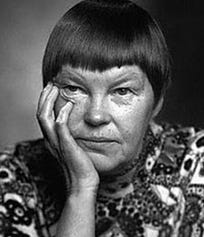|
 |
TWA from Sunday, May 28, 2017
“At the Pitch” by Maxine Kumin from Where I Live: New & Selected Poems. © Norton & Company, 2010.
ORIGINAL TEXT AND AUDIO - 2017
Today is the birthday of American poet May Swenson, born Anna Thilda “May” Swenson, in Logan, Utah (1913). Swedish was the primary language in her house, and Swenson was an avid reader from a young age, with one of her favorite writers being Edgar Allan Poe. She was the eldest child in a Mormon household, though she didn’t practice Mormonism as an adult. When asked what role spirituality might play in her writing process, she answered: “I’m on a search, although I didn’t deliberately set out to make a search in poetry. I have a philosophical bent which harks back to a religious background that I abandoned. Other poets may not be on any search other than into their own selves. But I’ve been on a search into the universe and the human mind.”
After college, she relocated to New York City, where she lived for most of her life. Swenson worked as a stenographer, ghostwriter, secretary, and finally, at a publishing house. She started publishing poems in magazines like The New Yorker, which paid her 49 dollars for the poem “Snow by Morning.” In all, she published nine collections of poetry, including Half Sun Half Sleep (1967) and In Other Words (1987), and became very famous for a style that she called “Iconograph,” which meant that she shaped the lines of a poem to form images relating to the poem’s content. For instance, her poem “The Lowering,” a tribute to Robert F. Kennedy, is in the shape of a folded flag. When asked how she came up with her poems, Swenson said: “When I talk about my work, I don’t say, ‘I wrote,’ I say, ‘I made,” or ‘I am making.’ I want my poems to be like three-dimensional objects instead of just words on the page. I want them to have that immediacy, as if you could walk around them, see them from several aspects, notice many facets.”
On poetry, May Swenson said: “The best poetry has its roots in the subconscious to a great degree. Youth, naivety, reliance on instinct more than learning and method, a sense of freedom and play, even trust in randomness, is necessary to the making of a poem.”
Swenson is buried on College Hill in Logan, Utah. There’s a marble bench on her grave with a pedestal. Carved into the pedestal is a line from her poem “The Wonderful Pen.” It says, “Read me. Read my Mind.”
It’s the birthday of American novelist Walker Percy, born in Birmingham, Alabama (1916). He is known most for his first novel, The Moviegoer (1961), which tells the tale of a young Southern man named Binx Bolling who is so alienated from the world that he prefers movies and books to people. He undergoes a spiritual and philosophical quest that had its roots in Percy’s time spent recovering from tuberculosis. Walker Percy had been working as a medical intern in Manhattan, performing autopsies on corpses, when he contracted the disease and had to spend two years in convalescence. That gave him plenty of time to read Russian novels and French philosophy, all of which he wrote into The Moviegoer. In the novel, when asked what the purpose of his journey is, Binx Bolling responds: “There is only one thing I can do. Listen to people, see how they stick themselves into the world, hand them along a ways in their dark journey and be handed along.”
The novel didn’t sell very well when it first came out, but it won the National Book Award, beating out more well-known books like Catch-22 by Joseph Heller and Franny and Zooey by J.D. Salinger. Walker Percy was already 45 years old when it was published, and he was mostly making a living by writing about Catholicism and spirituality and living off a small inheritance. The New York Times called him, “A medical doctor who didn’t practice and a Catholic who did.”
When Percy was 13, his father committed suicide and two years later, his mother drove off a cliff. He and his brother were adopted by an uncle, but the legacy of suicide and depression in his family would haunt him for the rest of his life. When he was a teenager, he and friend, a boy named Shelby Foote who grew up to be a famous playwright, took a car trip to see their literary idol, William Faulkner. Percy was so awestruck he couldn’t even get out of the car, and sat inside while Foote and Faulkner gabbed it up on Faulkner’s front porch.
After his bout with tuberculosis, Percy became a Roman Catholic (1946). When someone asked if his beliefs influenced his fiction, he said, “If a writer writes from a sense of outrage — and most serious writers do — isn’t he by definition a moral writer?”
Walker Percy’s other books include The Last Gentleman (1966) and The Thanatos Syndrome (1982). In his book Love in the Ruins (1971), a character named Dr. T. More invents an instrument called a “lapsometer” that measures the health of the human spirit.
Be well, do good work, and keep in touch.®
Check out THE COLLECTED POEMS OF MAY SWENSON - CLICK HERE
You’re a free subscriber to The Writer's Almanac with Garrison Keillor. Your financial support is used to maintain these newsletters, websites, and archive. Support can be made through our garrisonkeillor.com store, by check to Prairie Home Productions P.O. Box 2090, Minneapolis, MN 55402, or by clicking the SUBSCRIBE button. This financial support is not tax deductible.

